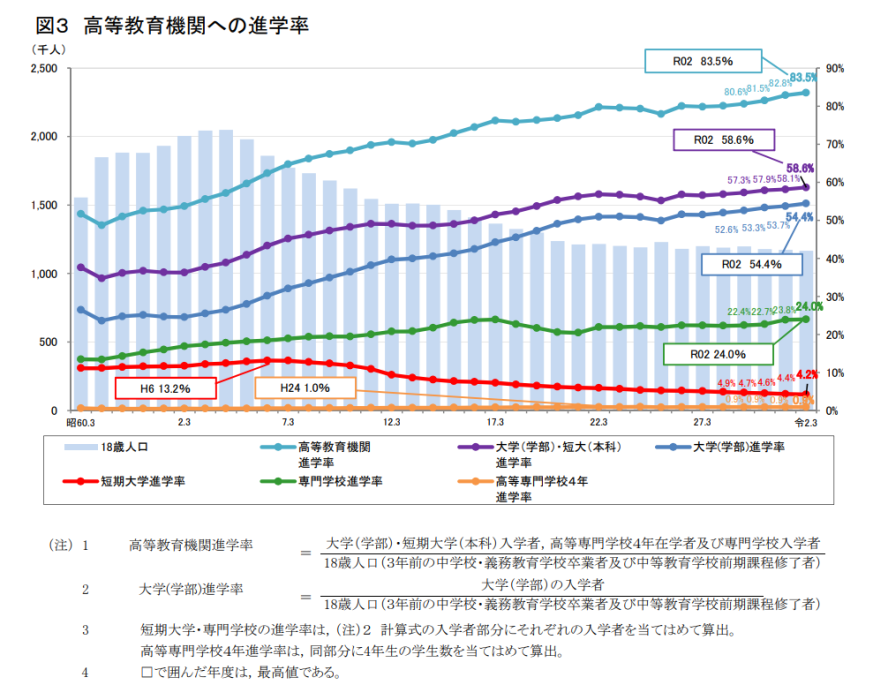For those of you considering studying abroad in Japan, you may not be familiar, or maybe confused, with the Japanese university system. Especially since there are many institutions with similar names, such as professional/vocational university, technical college, and specialised training college (vocational school), and what academic degree will you receive after graduation from each type of institution.
In this article, we will introduce the confusing “Japanese University System (日本の大学制度)” and the types of academic degrees. We will also introduce Japanese university entrance rates, the characteristics of the Japanese university system (pros and cons), and the Japanese university entrance exam schedule.
Cover Photo Credit: Soraie8288 / CC BY-SA
Table of Contents
- Japanese University System & Awarded Degrees
- Differences between Private, Public and National Universities
- The Rate of Admission to Higher Education Institutions in Japan
- Characteristics of Japanese Higher Education
- Summary
Japanese University System & Degrees Awarded

In this part, we will introduce the Japanese University System that centres on the type of education institution called “higher education institutions (高等教育機関)”, namely universities, vocational schools, and advanced vocational schools (specialised training colleges). We will also take a look at the degrees conferred upon graduation from each school, the content and duration of the course, and the number of units (credits) required.
【Read Me First】 Japanese universities (and also elementary, middle, and high schools) hold a school entrance ceremony in April as the start of a new school year. For universities, graduation is in March, and long vacations (長期休暇) are as follows:
-
Summer Vacation (夏休み): August to September (about 40 days)
-
Winter Vacation (冬休み): December to January (about 15 days)
-
Spring Break (春休み): February to April (about 60 days)
Each school has their own schedule, so please refer to the “Yearly Schedule (年間スケジュール)”, or “School Year Calendar (学年暦)” on each school’s website for detailed schedules.
1. University (大学) [2-year junior college, 4-year undergraduate programme, graduate school, professional college, etc.]
University (大学 daigaku): “Bachelor’s (学士)” degree
Bachelor's Course (学士課程). 4 year programme (acquire 124 units). Medicine, dentistry, pharmacy (for clinical purposes), and veterinary medicine are 6 year programmes (acquire 182~188 units).
What is “unit”? The concept of “credits” in Japanese universities.
In Japan, “credit” is called “unit (単位 tan-i)”. 2 units are acquired per semester for each class. Classes with the same name are divided into “Spring Semester (Japanese Modern Literature 1)” and “Autumn/Fall Semester (Japanese Modern Literature 2)”, and in many cases, students take 4 units per year. (Of course, just because you took (1) in the spring semester doesn't mean you have to take (2) in the autumn semester, but generally students will continue with (2) after taking (1)).
Class timetables (時間割) at many universities in Japan work like this:
1 Period (時限 jigen), also called 1 koma (コマ), is set as 2 units (90 minutes). The 2 units of 90 minutes will be treated as 2 hours (45 minutes = 1 hour). In other words, at universities, class periods are calculated not according to real time but according to “unit time (単位時間) = university time [academic hour]”.
Looking overseas for comparison, in the United States, 3 units per week [3 hours x 15 weeks] is common.
※ Ritsumeikan University, 『立命館産業社会論集』 第51巻 第4号 [2016.3] “大学の単位制度と学年暦─「1単位=45時間」と「1科目=1350分説(15週論)」─1)” written by 仲井 邦佳 (Nakai Kuniyoshi)
Junior College (短期大学 tanki daigaku): “Associate’s (短期大学士)” degree (before 2005,「準学士」)
2 year programme (acquire 62 units or more), or 3 year programme (acquire 93 units or more).
Graduate School (大学院 daigakuin): “Master's (修士)” or 'Doctor’s/Ph.D. (博士)' degree
-
Master's: 2 year programme (acquire 30 units or more).
-
Doctor’s/Ph.D.: 5 year programme (acquire 30 units or more): In the case of doctorate programmes that divide the first 2 years and the latter 3 years, first half+latter half is calculated. In this case, the first two years is often referred to as the “Master’s (修士) course”.
Professional/Vocational Universities (専門職大学 senmon shoku daigaku): 'Bachelor’s (professional) [学士 (専門職)]” degree
-
A university with a more in-depth specialised curriculum allowing students to acquire practical skills and abilities for certain professions that require specialisation. However, Professional /Vocational Universities cannot offer courses in medicine, dentistry, pharmacy (clinical purposes) and veterinary medicine.
-
4 year course (acquire 124 units + 40 units or more from practical/experimental/skill lessons, and 20 units or more of dual education off-campus training).
-
In the case of courses that divided the first half (2 or 3 years) and the latter course (2 or 1 year), those that completed the first half can receive an “Associate’s (professional) [短期大学士(専門職)]” degree.
Professional/Vocational Junior College (専門職短期大学 senmon shoku tanki daigaku): “Associate’s (Professional) [短期大学士(専門職)] “ degree
-
Among other junior colleges, this institution has a specialised curriculum for students to gain practical skills and abilities for certain specialised professions.
-
2 year course (acquire 62 units or more + 20 units or more from classes based on practical skills and experiments, and 10 or more units of dual education off-campus training).
-
3 year course (acquire 93 units or more + 30 units or more from classes based on practical skills and experiments, and 15 units or more of dual education off-campus training).
Professional Graduate School (専門職大学院 senmon shoku daigakuin): “Master’s [修士(専門職)]”, “Juris Doctor [法務博士(専門職)]”, “ Teaching Master’s [教職修士(専門職)]” degree
-
A graduate school specialised in nurturing highly specialised professionals who can play a leading role in their respective fields and society, as well as be active on an international platform. There’s “Graduate School of Law” for nurturing lawyers, “Graduate School of Education” for nurturing instructors/educators with high specialisation and qualifications, and etc.
-
Course Duration: 2 years or 1 year but less than 2 years as determined by each university. Graduate law school courses are 3 years or more.
- Professional Graduate School: 2 years (acquire 30 units or more)
-Graduate School of Law: 3 years (acquire 93 units or more)
-Graduate School of Education: 2 years (acquire 45 units or more)
2. Technical College (高等専門学校 koutou senmongakko) [High School + University]: “Associate’s (準学士)” degree
-
Technical College (高等専門学校 koutou senmon gakkou) is an educational institution that is easily confused with others. It is also called “kousen (高専)” for short.
-
It focuses on providing integrated education to graduates from middle school for 5 years. It aims, in particular, to train engineers who specialise in production. An easy way to remember and understand Kousen is that it’s a “high school+university”.
-
Foreign nationals can enter technical colleges from the 3rd school year through “academic transfer (編入学 hennyuugaku)”. However, there are conditions such as “must have completed at least 11 years of schooling in their home country” and “must have passed the academic proficiency test”, so you should inquire at each school for details.
-
Course Duration: 5 years (acquire 167 units or more). Merchant Ship (商船) related courses are 5.5 years (acquire 147 units or more).
The name of Japan’s high school academic proficiency test is “Certificate for Students Achieving the Proficiency Level of Upper Secondary School Graduates (高等学校卒業程度認定試験, or「高卒認定 kousou nintei」for short)”
Those who have reached 16 years of age or older, are high school graduates, and have never taken the test (previously known as “university entrance qualification test (旧大学入学資格検定)”) can take the test. The test is offered twice a year. In 2022, it will be held for two days each in August and November.
※ MEXT, “高等学校卒業程度認定試験(旧大学入学資格検定)” (Check for exact test dates.)
3. Vocational School (専門学校 senmongakko) [A “Specialized Training College (専修学校)” with specialized courses.]: “Diploma (専門士)”, “Advanced Diploma (高度専門士)” degree from a vocational school recognized by the Minister of Education, Culture, Sports, Science and Technology
-
The terms 「専門学校 senmongakko」 and 「専修学校 senshuugakko」 are confusing, especially since they both can be translated to “vocational school” in English. The standard name is 「専修学校」. Schools with dual education courses (educational+vocational training) may use the name 「専門学校」, except for Agricultural College (農業大学校).
-
With lessons based on high school curriculum, it is a school established for the purpose of nurturing skills necessary for work or real life, and improving general education.
-
Course Duration: 1 year or more.
- For daytime courses, 800 academic hours per academic year (1 academic hour = 45 minutes, so generally 600 hours a year), or acquire 30 units.
- For night courses, 450 academic hours per academic year (1 academic hour = 45 minutes, so generally 337.5 hours a year), or acquire 17 units.
- However, the minimum condition to graduate the course is 800 academic hours (600 hours), or acquire 30 units or more.
【Note】「学位」degree is awarded at higher education institution universities (大学 daigaku). At technical colleges (高等専門学校) and vocational schools (専門学校), students are awarded 「準学士」, 「専門士」 , 「高度専門士」diplomas.
In order to develop and maintain high-quality tertiary education in Japan, these higher education institutions are required to undergo a third-party review (accreditation evaluation) once every 7 years (once every 5 years for professional/vocational graduate schools).
※ National Institution for Academic Degrees and Quality Enhancement of Higher Education, “日本の教育制度について: 高等教育機関の種類>”
Writer's Pick
Differences between Private, Public and National Universities

Universities in Japan are divided into “private”, “public”, and “national” according to the entity.
-
Private (私立 shiritsu): Established and operated by a school corporation >> List of Private Universities by MEXT
-
Public (公立 kouritsu): Established and operated by a public university corporation and is funded by a local government>> Listof Public Universities by MEXT
-
National (国立 kokuritsu): Established by a national university corporation (from 2004 onwards), each university operates autonomously and is funded by national taxes. At least one in each prefecture. >> List of National Universities by MEXT
National University Features
-
Generally there are not many national universities, which is why entrance exams must be taken to qualify for entry. There is no difference in tuition fees between courses, as compared to private universities where tuition costs may vary greatly between courses. As of 2021, there are 803 universities in Japan, of which 86 are national universities. Think of it as about 10% of all universities in Japan.
-
Many national universities have a long history, for example the “Former Imperial Universities (旧帝大)” established in 1886.
-
61.8% of international students attending graduate school are enrolled in national graduate schools.
-
National universities are not very different from public universities, so they are sometimes grouped together as「国公立 kokkouritsu (national and public)」. However, it is important to know that the entrance examination for private universities is different (introduced below).
Public University Features
-
Public universities are funded and operated by local government bodies (地方公共団体) such as prefectures (都道府県) and municipalities (市町村). Therefore, it is characterised by having cheaper tuition fees for those who live in the area.
-
Public universities are often small scale institutions, with fewer departments & faculties.
-
In some cases, a private university may acquisite a public university corporation and continue operations as a public university.
-
As of 2021, there are 99 public universities in Japan.
※ MEXT, “学校基本調査-令和3年度 結果の概要-”, “公立大学基礎データ”
Private University Features
-
Each private university has its own features.
-
Tuition fees are more expensive than national schools.
-
There are various forms of entrance examination (eg. AO entrance examination, entrance examination for recommended students, etc.). The Common Test for University Admissions (大学入学共通テスト), which must be taken for national and public university entrance exams with almost no exceptions, is also often used for private universities as well. However, there are also private universities who do not use this common test but use individualised entrance exams for entry into the university, or a specific faculty (course),
The Rate of Admission to Higher Education Institutions in Japan
According to a survey by the Japanese Ministry of Education, Culture, Sports, Science and Technology, admission rates for higher education institutions (including universities) in 2020 was a record high of 83.5%. If you look at the graph below, you can see that though there are years showing a decline, the overall enrollment rate has been increasing every year.

Image Credit: MEXT「学校基本調査-結果の概要(令和2年度)」
In the graph above, the figures in boxes are the record highest enrollment rates for each educational institution type respectively. Let’s look at some of them - record high 54.4% for universities (Bachelor's programmes) and record high 24% for vocational schools.
Furthermore, according to the results of the survey on career path after graduating from university (undergraduate course), about 78% were “employed”. As for the statistics on those furthering education at other higher education institutions after graduating from university (undergraduate course), the rate was around 11%.
Characteristics of Japanese Higher Education

A brief coverage on the good points and problems in higher education in Japan. Please keep this in mind when considering studying abroad in Japan.
Advantages of Higher Education in Japan
The good thing about higher education in Japan is that there are several universities with world-class research institutes. Private universities not only pursue profits, but also make efforts to meet students demands while increasing efficiency. The compulsory evaluation of higher education institutions mentioned above can also be counted as a contributing factor in maintaining high quality of education.
Problems in Higher Education in Japan
It is a fact that Japan's higher education has been pointed out as lagging behind global education standards. Compared to education methods practised in other countries that value international views and approaches, Japan's higher education is still lacking. In addition, the reality is that there are many universities in Japan that have a short supply of funds, except for some famous universities.
Summary

The Japanese university system often feels complicated to foreigners. There are many types of higher education institutions such as universities and graduate schools, technical colleges, special training colleges, vocational schools, and junior colleges. .
If you are considering studying in Japan, it is important to understand the university education system in Japan to find a school that suits you best.



































